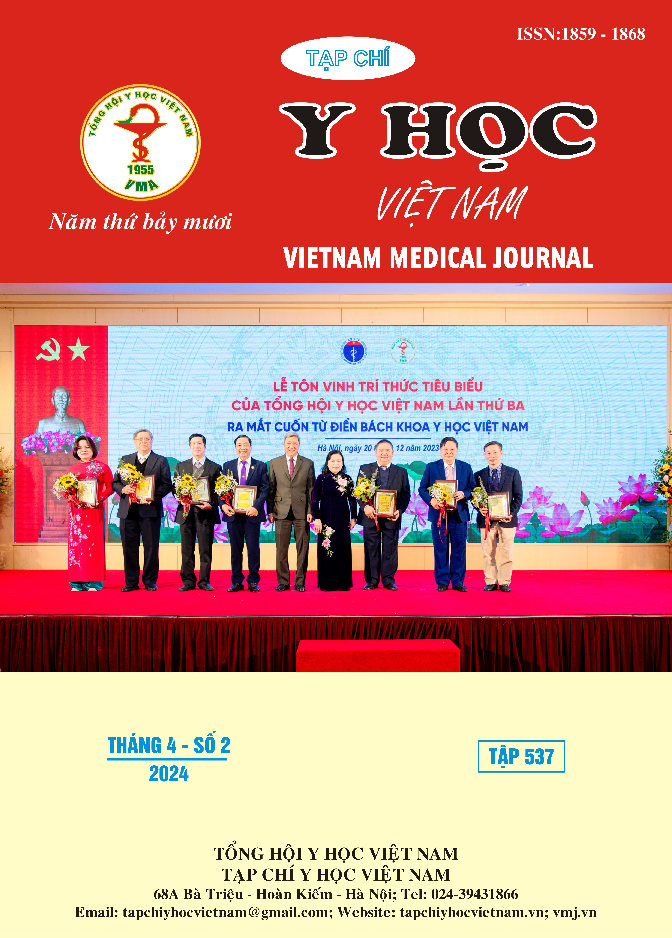SURVEY OF CHARACTERISTICS OF CEREBRAL VASCULAR OBSTRUCTION IN MRI 3 TESTA AND CYP2C19 GENETIC POLYMORPHISMS IN ISCHEMIC STROKE PATIENTS
Main Article Content
Abstract
Objective: Examine the characteristics of cerebrovascular damage and assess the CYP2C19*2 and CYP2C19*3 gene polymorphisms in ischemic stroke patients at Can Tho Stroke International Services. Materials and methods: Conduct a cross-sectional descriptive study involving 83 ischemic stroke patients diagnosed using 3 Tesla MRI or subtraction cerebral angiography at Can Tho Stroke International Services. Results: The study group had a male-to-female ratio of 2:1, with an average age of 63.96 ± 11.91. Severe target vessel stenosis predominated in 54.1% of cases based on 3T MRI and DSA. Arterial stenosis lengths less than 5mm were observed in 36 cases (59%). M1 middle cerebral artery stenosis had the highest incidence, constituting 38% and 33.3% of cases in the 3T MRI and DSA diagnostic methods, respectively. In terms of Clopidogrel metabolism and CYP2C19 2, 3 gene polymorphisms, only 42.2% of patients exhibit normal metabolism, while 12% have poor metabolism, and 45.8% show intermediate metabolism. Notably, 56.6% of patients carry the CYP2C19*2 polymorphism, with the CYP2C19*1*2 heterozygous form accounting for a significant portion (47%) and the CYP2C19*2*2 homozygous form comprising 9.6%. Additionally, 3.6% of patients carry the CYP2C19*3 polymorphism, all of whom are CYP2C19*1*3 heterozygous. Conclusion: A high proportion (57.8%) of patients carry CYP2C19*2 and CYP2C19*3 genes, which result in reduced or lost Clopidogrel activity. The heterozygous *2 allele is the most commonly observed
Article Details
Keywords
Ischemic stroke, MRI 3testla, DSA, Clopidogrel, CYP2C19.
References
2. Trần Hòa (2020), Nghiên cứu mối liên quan giữa kiểu gen giảm chức năng CYP2C19*2,*3 và tiên lượng ở bệnh nhân được can thiệp đặt stent động mạch vành có điều trị Clopidogrel, Luận án tiến sĩ Y học, Đại học Y Dược Thành phố Hồ Chí Minh, Thành phố Hồ Chí Minh.
3. Trịnh Viết Thắng (2011), Nghiên cứu một số đặc điểm dịch tễ học đột quỵ não và hiệu quả bài tập phục hồi chức năng tại nhà ở tỉnh Khánh Hòa, Học Viện Quân Y, Hà Nội.
4. Vũ Ngọc Trung (2021), Nghiên cứu tần suất đa hình gen CYP2C19 và mối liên quan với kết quả điều trị chống ngưng tập tiểu cầu ở người bệnh hội chứng vành cấp, Trường đại học Y Hà Nội, Hà Nội.
5. Bang, O. Y., et al. (2009), "Impact of metabolic syndrome on distribution of cervicocephalic atherosclerosis: data from a diverse race-ethnic group", J Neurol Sci. 284(1-2), pp. 40-5.
6. Kim, B. J. and Kim, J. S. (2014), "Ischemic stroke subtype classification: an asian viewpoint", J Stroke. 16(1), pp. 8-17.
7. Kim, K. A., et al. (2010), "Assessment of CYP2C19 genetic polymorphisms in a Korean population using a simultaneous multiplex pyrosequencing method to simultaneously detect the CYP2C19*2, CYP2C19*3, and CYP2C19*17 alleles", J Clin Pharm Ther. 35(6), pp. 697-703.
8. Oestreich, J. H., Best, L. G., and Dobesh, P. P. (2014), "Prevalence of CYP2C19 variant alleles and pharmacodynamic variability of aspirin and clopidogrel in Native Americans", Am Heart J. 167(3), pp. 413-8.
9. Tassaneeyakul, W., et al. (2006), "CYP2C19 genetic polymorphism in Thai, Burmese and Karen populations", Drug Metab Pharmacokinet. 21(4), pp. 286-90.
10. Zhong, Zhixiong, et al. (2018), "Effect of cytochrome P450 2C19 polymorphism on adverse cardiovascular events after drug-eluting stent implantation in a large Hakka population with acute coronary syndrome receiving clopidogrel in southern China", European Journal of Clinical Pharmacology. 74.


